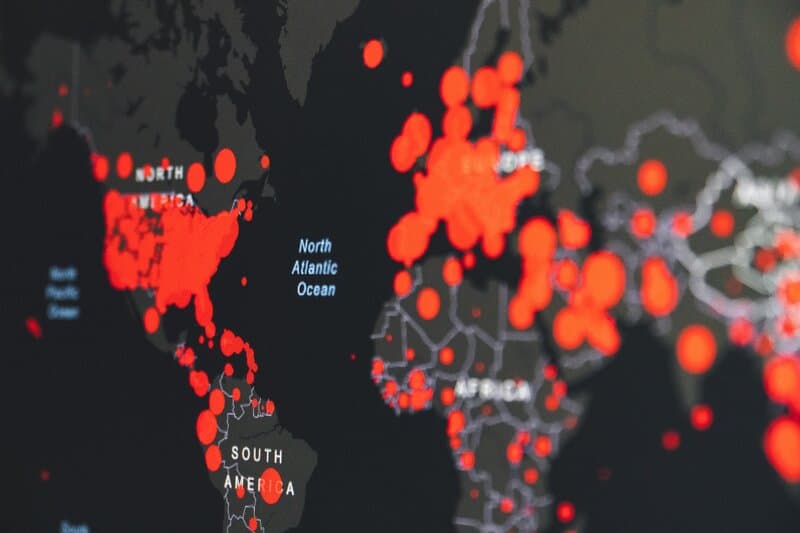As COVID-19 continues its relentless impact on the world, scientists have begun to discuss the best ways to handle subsequent pandemics, or prevent them entirely. This past July, the Intergovernmental Science-Policy Platform on Biodiversity and Ecosystem Services (IPBES) held a virtual workshop which brought together the world’s top epidemiologists, public health experts, zoologists, disease ecologists, comparative pathologists, veterinarians, pharmacologists, wildlife health experts, mathematical modelists, economists, lawyers and public policy makers to discuss the prevention of future pandemics.
—
COVID-19 is a zoonotic disease, an illness in which infectious microbes are transferred from animals to humans. The World Health Organization (WHO) reports that “more than three-quarters of the human diseases that are new, emerging or reemerging at the beginning of the 21st century are caused by pathogens originating from animals or from products of animal origin.” Zoonotic diseases first emerged over 10 000 years ago when humans began domesticating animals, such as goats and sheep, for meat, milk and skin.
With the domestication of wild species came the rapid emergence of infectious diseases spreading from animals to humans. Rinderpest virus, a disease of ruminants, morphed into measles, which killed 140 000 people in 2018 alone. Camelpox, a disease only impacting camels, turned into smallpox, killing over 300 million people throughout the 20th century. With the domestication of pigs came whooping cough, which still infects 10 000- 40 000 US children annually. Even the common cold emerged with the domestication of cattle, while leprosy originated in water buffalo. The Spanish flu of 1918, which killed 50 million people, was of avian origin; the Ebola outbreak began when humans had contact with blood and bodily fluid of chimpanzees and gorillas. Most recently, COVID-19, which has already killed 2.5 million people worldwide, is presumed to have originated from humans improperly handling animal products in wet markets.
You might also like: Kenya Opens Bids to Expand Crop Insurance for Climate Change
While animals have been domesticated since 9 000 BC, incidences of zoonotic diseases increased drastically during the latter half of the 20th century. Beginning in 1975, 30 new infectious diseases have emerged in 30 years. Additionally, 2020 statistics suggest that every year, five new infectious diseases emerge in humans, each new strand posing a risk of a potential new pandemic. Of these new infections, scientists claim 75% of emerging diseases originate in animals, while almost all known pandemics are zoonotic. While zoonotic diseases begin in animals, scientists claim “their emergence is entirely driven by human activities.” Land deforestation, animal agriculture, wildlife trade, decreases in biodiversity and climate change are just some of the human-driven factors leading to increases in zoonotic disease.
For example, IPBES’s workshop found that 30% of zoonotic diseases are attributed to recent changes in land-use, animal agriculture expansion and growing human urbanisation. Increases in deforestation and its link to zoonotic diseases is two-fold. The first risk for transmission of animal microbes to humans happens when companies enter biodiverse environments to clear land, exposing themselves to diseases within the natural habitats. The second risk arises when surviving animals are forced to relocate after natural habitats are destroyed by deforestation, which sometimes brings them closer to human living spaces. A 2017 study found that since 1976, 25 new Ebola outbreaks have occurred as a result of human-animal interaction before and after deforestation. One case highlights a 18-month old child who contracted and died from Ebola after unknowingly playing near a bat’s nest in his backyard which had relocated after a nearby deforestation event.
Greater human consumption of animal products is another driving force behind increased incidences of zoonotic disease. The World Health Organization, Food and Agriculture Organization of the United Nations and the World Organization for Animal Health listed “increasing demand for animal protein” as number one on their list of “the top 4 risk factors for emergence and spread of new zoonotic diseases.”
Farmers and slaughterhouse workers regularly come in contact with animal blood, secretions and bodily fluids, greatly increasing the chance for animal microbes to jump species. Furthermore, in order to maximise profits, farmed animals have been bred to be nearly genetically identical to one another and are overpacked into small spaces in factory farms. The genetic similarity allows viruses to spread among large populations of animals without having to mutate, while the densely packed populations allow for many animals to become infected quickly. Animals in factory farms are reservoirs for diseases while factory workers, slaughterhouse workers and meat consumers are susceptible hosts for the virus to infect across species.
COVID-19 has been referred to as a “1 in 100-year pandemic, ” suggesting a global scale contagion will not likely happen again in our lifetime. However, scientists predict that “without prevention strategies, pandemics will emerge more often, spread more rapidly, kill more people and affect the global economy with more devastating impact.” As of July 2020, COVID-19 has cost the global economy upwards of USD$15 trillion. It’s estimated that the global response to the pandemic has been 100 times more expensive than the prevention would have cost.
During the virtual workshop, IPBES recognised that pandemics are handled retroactively and rarely rely on prevention. The workshop highlighted the world’s efforts to quickly develop and distribute a vaccine after COVID-19 had emerged. “COVID-19 demonstrates that this is a slow and uncertain path, and as the global population waits for vaccines to become available, the human costs are mounting, in lives lost, sickness endured, economic collapse and lost livelihoods.”
IPBES emphasised a transition to preventative measures. Some of the workshop’s suggestions included creating an intergovernmental council on pandemic prevention and assessing the risk of emerging disease in land use projects while considering human health. Other suggestions include reducing high-risk species from wildlife trade, educating all sectors of society on emerging infectious disease hotspots and investing in habitat restoration measures. The workshop even considered implementing new taxes on high pandemic risk behaviours, such as meat consumption and production.
In 2005, Dr. Michael Osterholm, director of the US Center for Infectious Disease Research and Policy, predicted “an influenza pandemic of even moderate impact will result in the biggest single human disaster ever.” Although devastating, COVID-19 was predictable. Unfortunately, the IPBES reports that mammals are currently reservoirs to another estimated 1.7 million undiscovered viruses. Scientists believe that anywhere from 631 000 to 827 000 of these viruses are able to gravely impact human health in the future. Global efforts must be made for the prevention of subsequent pandemics altogether, rather than relying on cures once they occur.


















